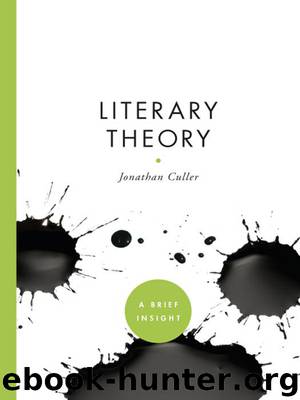Literary Theory by Culler Jonathan

Author:Culler, Jonathan
Language: eng
Format: epub
ISBN: 9781402782121
Publisher: Sterling Publishing
Published: 2010-12-06T16:00:00+00:00
Rhetorical Figures
Literary theory has been much concerned with rhetoric, and theorists debate the nature and function of rhetorical figures. A rhetorical figure has generally been defined as an alteration of or swerve from “ordinary” usage; for instance, “My love is a rose” uses rose to mean not the flower but something beautiful and precious (this is the figure of metaphor). Or “The Secret Sits” makes the secret an agent capable of sitting (personification). Rhetoricians formerly attempted to distinguish specific “tropes” which “turn” or alter the meaning of a word (as in metaphor) from more miscellaneous “figures” of indirection which arrange words to achieve special effects. Some figures are: alliteration (the repetition of a consonant); apostrophe (addressing something that is not a regular listener, as in “Be still, my heart!”); and assonance (the repetition of a vowel sound).
Recent theory rarely distinguishes figure from trope and has even questioned the notion of an “ordinary” or “literal” meaning from which figures or tropes swerve. For example, is the term metaphor itself literal or figurative? Jacques Derrida, in “White Mythology,” shows how theoretical accounts of metaphor seem inevitably to rely on metaphors. Some theorists have even embraced the paradoxical conclusion that language is fundamentally figurative and that what we call literal language consists of figures whose figurative nature has been forgotten. When we talk of “grasping” a “hard problem,” for instance, these two expressions become literal through the forgetting of their possible figurality.
From this perspective, it’s not that there is no distinction between literal and figurative but rather that tropes and figures are fundamental structures of language, not exceptions and distortions. Traditionally, the most important figure has been metaphor. A metaphor treats something as something else (calling George a donkey or my love a red, red rose). Metaphor is thus a version of a basic way of knowing: we know something by seeing it as something. Theorists speak of “metaphors we live by,” basic metaphorical schemes, like “life is a journey.” Such schemes structure our ways of thinking about the world: we try to “get somewhere” in life, “find our way,” “know where we’re going,” “encounter obstacles,” and so on.
Metaphor has been treated as basic to language and the imagination because it is cognitively respectable, not inherently frivolous or ornamental. Its literary force, though, may depend on its incongruity. Wordsworth’s phrase “the child is father of the man” stops you, makes you think, and then lets you see the relationship of generations in a new light: the child’s relationship to the man he later becomes is compared to a father’s relation to his child. Because a metaphor can carry an elaborate proposition, even a theory, it is the rhetorical figure most easily justified.
But theorists have also stressed the importance of other figures. For Roman Jakobson, metaphor and metonymy are the two fundamental structures of language: if metaphor links by means of similarity, metonymy links by means of contiguity. Metonymy moves from one thing to another that is contiguous with it, as when we say “the Crown” for “the Queen.
Download
This site does not store any files on its server. We only index and link to content provided by other sites. Please contact the content providers to delete copyright contents if any and email us, we'll remove relevant links or contents immediately.
4 3 2 1: A Novel by Paul Auster(12284)
The handmaid's tale by Margaret Atwood(7679)
Giovanni's Room by James Baldwin(7192)
Asking the Right Questions: A Guide to Critical Thinking by M. Neil Browne & Stuart M. Keeley(5635)
Big Magic: Creative Living Beyond Fear by Elizabeth Gilbert(5613)
Ego Is the Enemy by Ryan Holiday(5294)
The Body: A Guide for Occupants by Bill Bryson(4974)
On Writing A Memoir of the Craft by Stephen King(4863)
Ken Follett - World without end by Ken Follett(4645)
Adulting by Kelly Williams Brown(4487)
Bluets by Maggie Nelson(4474)
Eat That Frog! by Brian Tracy(4435)
Guilty Pleasures by Laurell K Hamilton(4360)
The Poetry of Pablo Neruda by Pablo Neruda(4039)
Alive: The Story of the Andes Survivors by Piers Paul Read(3968)
White Noise - A Novel by Don DeLillo(3954)
Fingerprints of the Gods by Graham Hancock(3942)
The Book of Joy by Dalai Lama(3899)
The Bookshop by Penelope Fitzgerald(3775)
